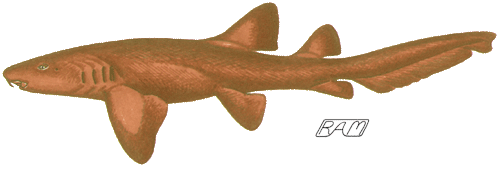Origin of The Name "Nurse" Shark

The origin of the name "Nurse Shark" is obscure. But, as is often the case with etymological research, a bit of time invested in poking through old books can reveal some fascinating insights into the history of contemporary words we use so casually we often take them for granted. Such is the case with the question at hand.
According to Lineaweaver and Backus' excellent — though dated — book The Natural History of Sharks (originally published by Lippincott in 1970, but still available in paperback through Nick Lyons Books, New York):
"Possibly, some bygone observer watched a shark giving birth to live young and thought the shark was giving nurse. Possibly the use of the word sprang from the old notion that a shark would protect its young by taking them into its mouth."
The first of these speculations seems more likely than the second, as the species in question (Ginglymostoma cirratum) is ovoviviparous, giving birth to live young that squirm forth from the cloaca. Although many species of bony fishes (from freshwater cichlids to saltwater catfishes and cardinalfishes) incubate or protect their eggs by taking them into the mouth, this behavior has not been reported from any elasmobranch and — given the relatively protracted gestation period of elasmo eggs — is not expected to occur.
Lineaweaver and Backus continue,
"But the Oxford English Dictionary points to another possibility. In medieval times the n of an was frequently transferred to a following word that began with a vowel. Huss, husse and hurse were long-ago names for dogfish and other sharks as well. Nurse survives and so does huss"
Lineaweaver and Backus preface their case with quotations from 16th and 17th century natural history books, providing examples of use of the words "nuse" and "nurse-fish" for what we now call a Spiny Dogfish (Squalus acanthias) in a way entirely consistent with the above hypothesis (see pages 142-3). When early European explorers and naturalists ventured to distant lands and saw species new to them, they often wrote of these unfamiliar creatures in terms of those they knew from their homeland. Hence, we have Australian 'salmon' and 'mynah birds' that are not closely related to their antipodean counterparts. Thus, the "nurse" part of G. cirratum's vernacular name may be a holdover from an Old English word first applied to this New World species hundreds of years ago.
If I may be permitted a bit of didacticism, the best answers to questions do not necessarily come from the latest television documentaries, web pages, or glossy picture books. Sometimes the best sources of information are old and nearly forgotten volumes, mouldering and gathering dust in academic institutions and archives. Good work never goes out of date, whether it be 30 or 300 years old. Litera scripta manet!
— R. Aidan Martin
[Posted to SHARK-L Jan 24, 1998]
Responding to a related posting, ["I believe that the name nurse shark comes from some place in the south Pacific where they called it a plurse shark. The name was then slurred into nurse shark."], I had the following thoughts.
'Plurse' sounds rather like an example of the pidgin English widely spoken throughout much of Melanesia, suggesting the possibility that it was the South Pacific Islanders who slurred the English word 'nurse' and that ipso facto the English term for the shark in question predates the South Pacific one.
I would suggest that the etymology of the term 'nurse shark' is pretty much as traced by Lineaweaver and Backus (1970) — see my post of 1/24/98 for a discussion. Use in English of the name 'nuse' or 'nurse-fish' dates back to the 1550's, when it was apparently used for what we now know as the Spiny Dogfish (Squalus acanthias). The term 'nusse' or 'nurse' was later extended to describe any large fish, especially a shark. Although the Spanish and Dutch had been poking about the South Pacific since about 1520 and 1642, respectively, the English didn't begin exploring this region in earnest until 1768, with the first voyage of Captain James Cook. Therefore, English use of the term 'nurse' to refer to a shark predates earliest British contact with South Pacific islanders.
It is worth noting in passing that the Nurse Shark of the central and western South Pacific and Indian oceans is not the familiar Ginglymostoma cirratum of the Atlantic and eastern Pacific, but the Tawny Nurse Shark, Nebrius ferrugineus (= N. concolor). Although the nurse and tawny sharks superficially resemble one another, the latter is readily distinguished from the former by the pointed apices of its pectoral, dorsal, and anal fins, narrowly falcate pectoral fins, and laterally compressed teeth in the sides of the jaw. These differences have long been regarded as evidence that these orectoloboid sharks warrant different genera.
